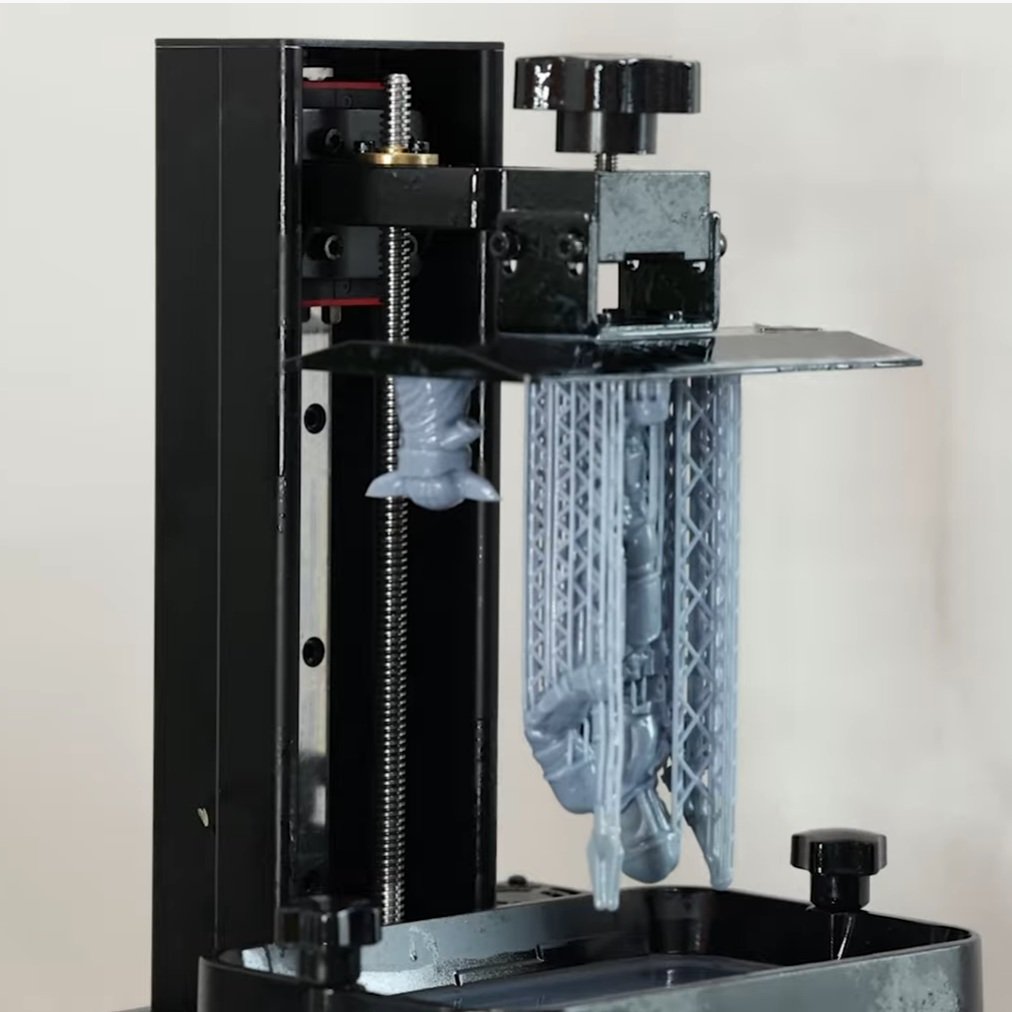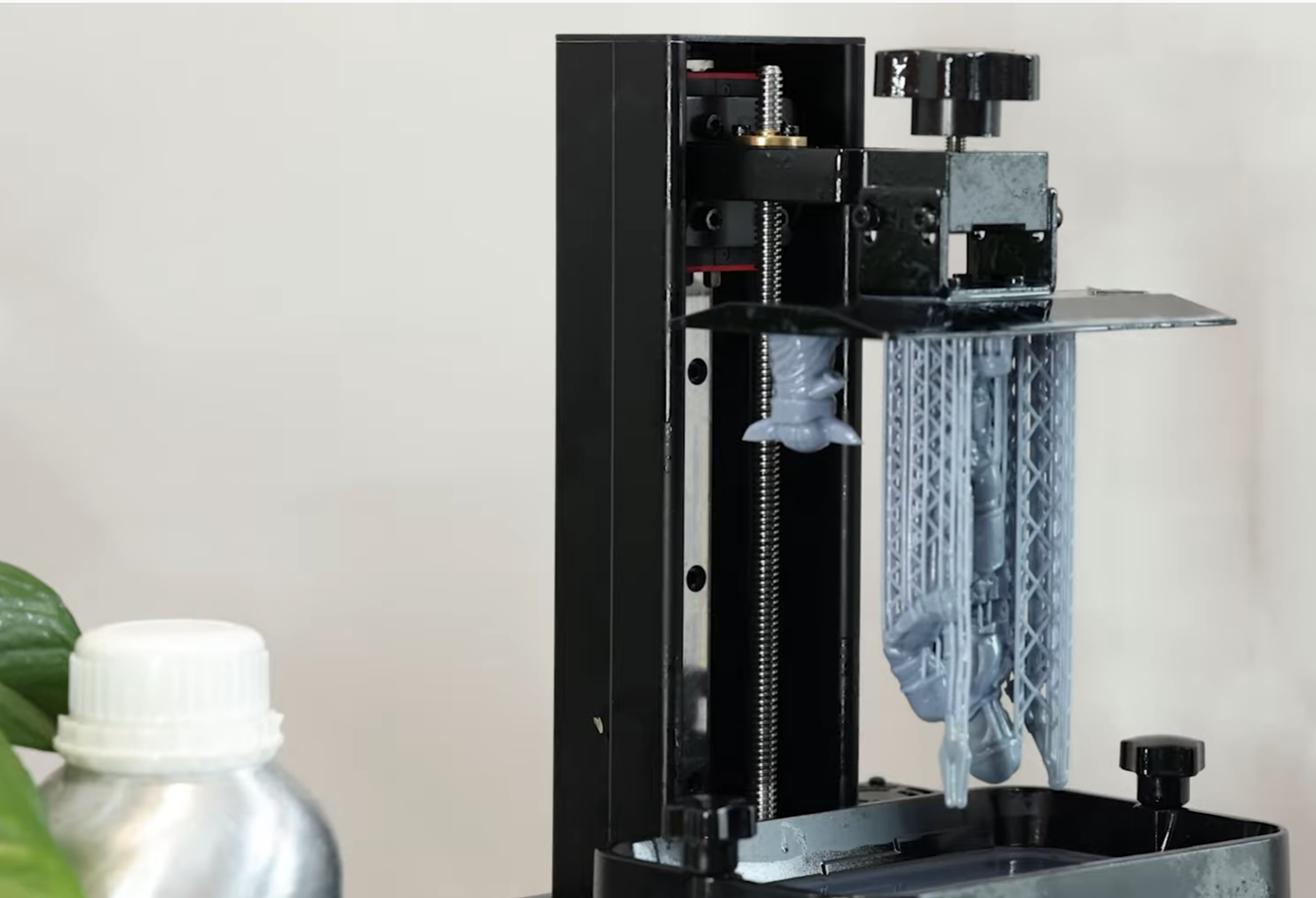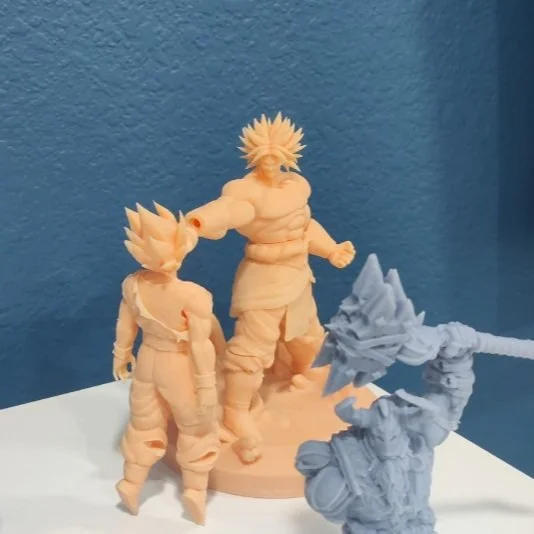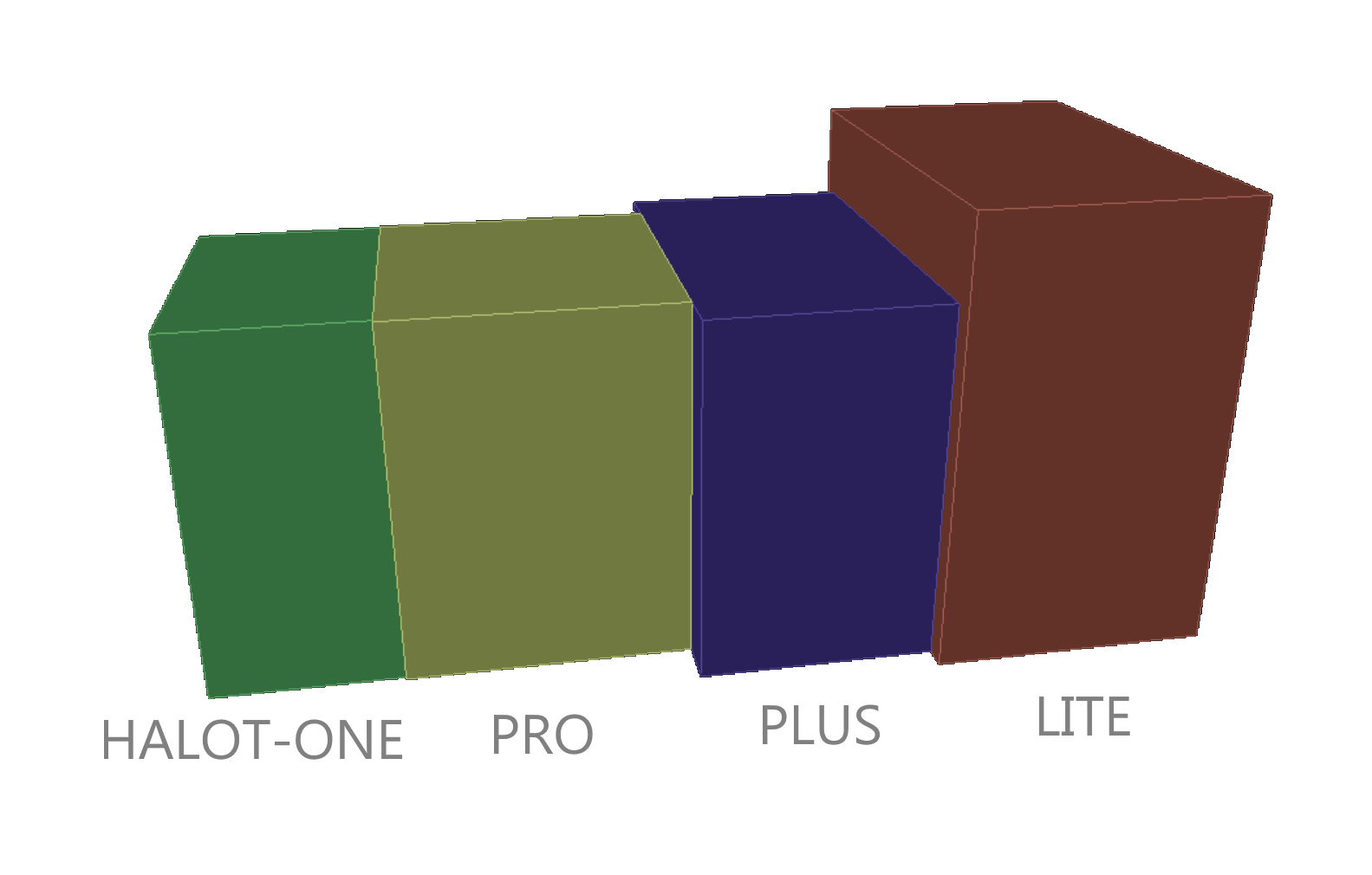Choosing A Creality Resin 3D Printer
If you’re looking for a resin 3D printer for either hobby or professional use, it’s hard to go wrong with one of Creality’s resin 3D printers. In this article, we’ll take a look at all of the resin 3D printers Creality produces and compare the features of each to help you decide which one is best for you.
If you aren’t sure if a resin or FDM 3D printer is the right choice for you, we recommend that you first read our article Choosing a 3D Printer: Filament or Resin? guide to understand the differences between these two technologies and get a better idea how resin 3D printers work.
Why Creality?
A completed print on the HALOT-ONE Creality resin printer, a popular entry level choice. Image from Creality marketing materials
The main reason we choose Creality 3D printers is because they offer an impressive level of quality and reliability at a great price. As part of our 3D printing business 3DPros, we operate over a dozen Creality printers nearly continuously. We’ve been continually impressed at the reliability of the printers and have had to make very few repairs even with 24/7 operation. For our business, having a printer failure is a major issue that affects our ability to fill orders for our customers, so we’re motivated to find reliable printers that won’t let us down.
Creality started with producing filament printers, and entered the low-cost resin space in 2020 with the LD-002 at a time when DLP 3D printing technology was becoming more affordable, making resin-based printing much more accessible to hobbyists. Previously, resin printers used SLA technology, which uses a targeted laser to cure the resin on each layer. DLP instead uses a UV LCD screen—basically a small single color monitor that emits UV light—to cure the resin on each layer. Creality improved on the existing 3D printers in the market with innovations like a custom-designed light source for improved consistency and an air filtration system to reduce resin odors.
Almost all of Creality’s resin printers include an air filtration system to reduce the odors from liquid resin, which is a great feature if you will be keeping the printer in a room that you will be occupying frequently.
Which Creality 3D Printer Is Right For You?
Note: This article focuses on Creality’s resin 3D printers; if you are interested in FDM 3D printing, you’ll want to refer to our overview of Creality’s FDM 3D printers. If you aren’t sure what the difference is between these technologies, read our Filament vs. Resin article to get an overview and learn which one is a better fit for you.
Creality is known for producing a variety of different models of 3D printers, and their resin 3D printer lineup is no exception. While the number of options can be overwhelming, it allows you to choose a printer that has only the features you need. We recommend first thinking about your budget to start narrowing down your search. To help with this, we will look at the printers in order of price, starting from the entry-level machines and moving toward the more premium and larger resin printers.
Note: Creality Experts receives a commission for items you purchase from this page, at no additional cost to you. For more information, please see our affiliate link policy.
If you’re just getting into 3D printing or if price is an important factor in your decision, an entry-level Creality resin printer will be a good choice. Entry-level machines have a smaller build volume and a lower price--it’s not always better to get a more expensive machine! In addition to the lower cost, these machines have a very small footprint, so you won’t need as much dedicated space for them.
Top Choice: HALOT-ONE
The HALOT-ONE is the smallest and most affordable resin printer in the HALOT line, which Creality introduced in 2021. It has a smaller build volume of 127 x 80 x 160 mm, however this volume is a bit more generous than other budget 3D printers, such as the Elegoo Mars, which has a volume of 120 x 68 x 155 mm. It uses a 2K resolution LCD, which is typical of budget resin printers, and is still capable of producing very fine details due to the smaller build volume.
All of the printers in the HALOT series use a custom-designed light source technology (Integral Light Source) to provide the UV backlight for the LCD, which provides a much more even lighting base. This ensures that resin is cured equally in all locations. Additionally, this technology uses redundant LEDs, so the light will continue to work even if one of the LEDs fails.
Traditional Parallel Emmision (left) provides a less even light source than Creality’s Integral Light Source technology (right). Images provided by Creality.
The HALOT series additionally uses a monochrome LCD, which allows for faster printing and in increased service life. Monochrome, or mono, LCDs are designed to only amit a single wavelength of light (the 05nm UV light which cures resin), and are therefore optimized for this task.
Additionally, the HALOT series adds WiFi connectivity, a convenient feature that allows you to print without a USB connection or needing to manually transfer an SD card between your computer and the 3D printer.
Due to these added features and the surprisingly low price increase of ~$20 over the older LD-002R, we feel that the added features of the HALOT series are well worth the cost.
The print samples below show the level of detail and print quality you can expect from the HALOT-ONE:
Value Choice: LD-002R
The LD-002R was the first resin 3D printer released by Creality, and it lacks some of the newer features of the HALOT series, specifically the updated Intergral Light Source backlight, Monochrome LCD, and wireless connectivity. However, if you are looking for the least expensive option, you’ll still be able to get decent prints out of the LD-002R at a lower price point. However, since the price difference is not a lot (typically ~$20), we feel that the added features of the HALOT series are usually worth the extra cost.
The printers in this category offer higher resolution LCDs and larger print volumes than the entry-level resin printers. The increased volume is helpful for large parts, but it also allows you to increase the speed of printing when producing multiple parts at once. This is because the time it takes for a resin 3D printer to complete a job is based only on the number of layers, and doesn’t increase as you add more parts. If you’re not sure which class of printer you should get, we recommend opting for a standard size printer. These printers offer more versatility than the smaller Entry Level machines.
Top Choice: HALOT-ONE PLUS
The HALOT-ONE Plus is the most premium 3D printer in the HALOT ONE series, including both a substantially larger build volume and a 4K high-resolution LCD to ensure that the part quality and detail remains high even at the larger size. The build height is the same as the smaller HALOT-ONE at 160 mm, but the X and Y dimensions are increased substantially:
HALOT ONE: 127 x 89 mm x 160 mm
HALOT ONE PLUS: 172 x 102 mm x 160 mm
Like all of the printers in the HALOT series, it includes the improved ILS backlight and wireless connectivity.
Value Choice: HALOT-ONE PRO
If you are looking for a balance between cost and capability, the HALOT-ONE PRO is a great place to start. The build volume is smaller than the HALOT-ONE PLUS, but not by a significant amount, and actually is 20mm larger in the Y dimension with a more cubic volume. The biggest deficiency from the HALOT-ONE Plus is the less capable 3K LCD, but it will be hard to notice the difference in quality for parts without significant small details.
The pixel size (based on dividing the physical size of the LCD by the LCD resolution) is .051 mm, which is almost identical to the .050 mm of the original HALOT ONE, but is less than the .040 mm of the HALOT ONE PLUS. A smaller pixel size is better, as it indicates a higher-resolution screen that will result in more detailed prints.
The largest resin 3D printers unsurprisingly also cost the most, but offer the largest volume and LCD resolution. If you are looking to print large models, you may also want to consider FDM 3D printing, since even the largest of Creality’s resin 3D printers have a smaller build volume than even the budget FDM 3D printers like the Ender 3. However, if you are looking for the high quality of resin printing at the largest size possible, these printers will be a great place to start.
Top Choice: HALOT-LITE
A visual comparison of the relative sizes of the HALOT series build volume.
The oddly named HALOT-LITE doesn’t include “ONE” in the name, but it is essentially a larger version of the HALOT-ONE PLUS. It includes a high resolution 4K LCD and is larger in all dimensions, most significantly, an increase to the height. It’s pixel size is .050 mm, which is on par with the HALOT-ONE and PRO, but not quite as much as the HALOT-ONE PLUS, which has the same 4K resolution LCD but at a smaller size.
The price for the LITE is quite a bit more than the HALOT-ONE PLUS, so it is only really worth the price if you are looking to frequently print large parts or print many parts at the same time. Even so, the increase in volume is fairly modest considering the increase in price of over $100 from the HALOT-ONE PLUS.
Alternative: LD-006
The LD-006 is a bit older than the HALOT-LITE, but it offers an even taller Z build volume of 250 mm. Creality also claims that this printer has an easier FEP replacement system with pre-drilled holes. However, we were not able to find these online to purchase, and this does not seem like it would really save much time since the typical FEP replacement process involves using the screws to punch holes in the film.
Note: the FEP film lines the bottom of the vat containing the resin, and is a thin clear film that allows the UV light from the LCD to cure the resin while making sure the resin never contacts the LCD. The film gets scratches over time through normal use, and typically should be replaced every few months of printing time.
It is otherwise pretty much the same as the HALOT-LITE, but with a substantially higher price that we don’t really feel is worth it just for an extra 50mm of printing height.
Not Recommended: HALOT-SKY
The HALOT-SKY has very similar capabilities to the HALOT-LITE, but has a much higher price point for basically no additional benefits. This printer was released before the HALOT-LITE, so there may have been a case for buying it at that time, but in the current market there is no reason to consider this printer.
How to Make Your Choice
Choosing a resin 3D printer can be overwhelming since there are a lot of options available. If you aren’t sure where to start, print volume is an important factor to consider early on when choosing a 3D printer. We recommend considering what types of objects you’ll want to print most often and using that as a basis to choose a printer in the lineup. However, keep in mind that a larger printer can be used to print small objects as well, and you may find yourself really wanting a larger build area later. That said, the entry-level models in this list are affordable and are a great way to dip your toe in the resin and see if you enjoy this type of 3D printer. Ultimately, it’s hard to go wrong with any of the recommended options on this page.





